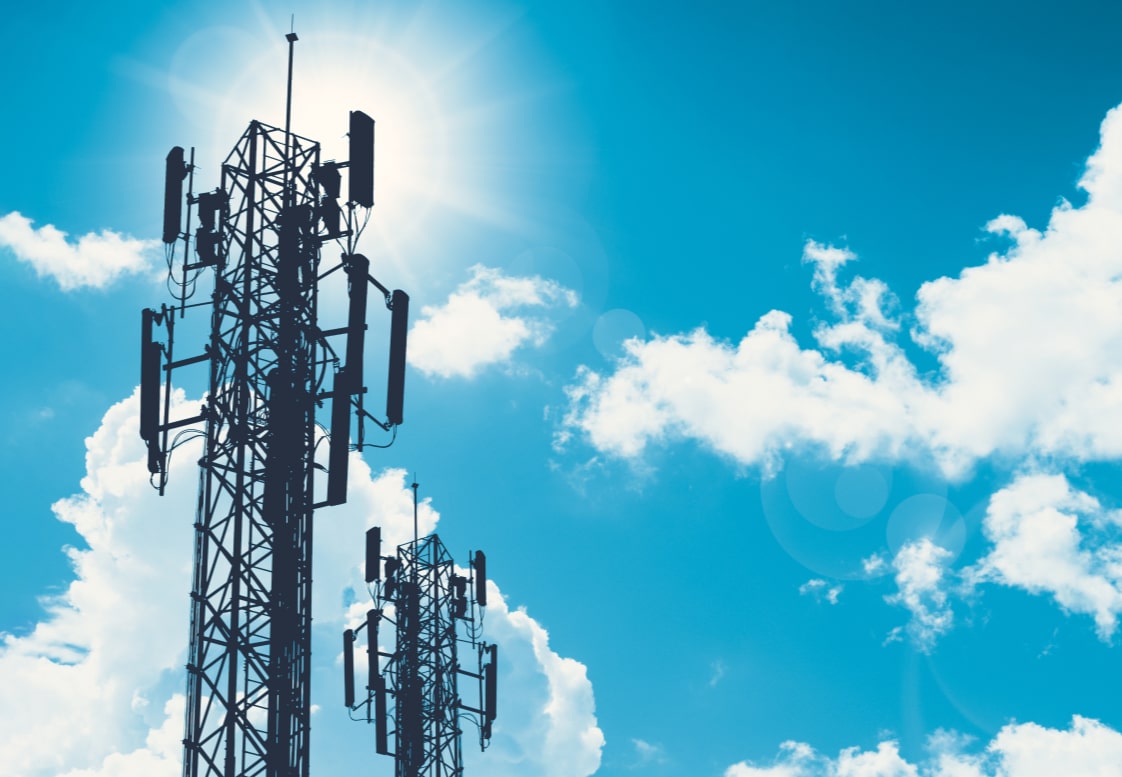The Professional Guide to Tower Maintenance

It’s easy to take fast and reliable telecommunications for granted, but these services heavily depend on physical infrastructure to provide much-needed consistent coverage.
When telecommunication towers fail, the cause is often delayed or neglected maintenance that allows preventable issues to reach a breaking point. This can lead to significant network downtime.
For telecom service providers, the revenue loss from downtime can quickly spiral into severe financial damage. One research institution estimated the average cost of network downtime to be $500,000 per hour, which has likely increased since that survey was conducted.
According to a recent survey, nearly a third of providers have lost more than a million dollars to telecom outages.
Keeping towers online and operational without interruption is a mission-critical priority for telecom companies. Many of the problems that lead to outages are preventable by engaging in regular maintenance.
Let’s walk through all the essentials you need to know to keep your telecom towers properly maintained, customers happy, and avoid hefty financial losses.
What are the current challenges facing telecom and site operators?
In the current era of global commerce, instantaneous digital communication is everything. Information and communications technology supports businesses’ need to engage in complex data-sharing interactions at all times. When interruptions and outages prevent them from doing so, it doesn’t take long before they start looking for new telecom providers that won’t let them down.
Maximizing uptime isn’t just about making money—when network services go down, essential utilities and emergency services may also be impacted. Major telecom providers like AT&T and Verizon have been fined millions of dollars for outages that made it impossible for their subscribers to connect to 911 call centers.
Outages are becoming more frequent, and equipment failure is one of the most common causes. As many as 43% of significant network outages are linked to power issues, most of which are caused by uninterrupted power supply (UPS) units breaking down.
With the latest 5G technology bringing even higher density relay systems, having efficient monitoring and maintenance solutions in place has never been more important.
Why should regular maintenance be carried out?
Telecommunication towers transmit the signals that make fast, long-distance wireless communication possible. Regular maintenance of the structures can prevent many problems that cause essential components to fail.
A recent study found that telecom sites can increase their efficiency by up to 40% by replacing old and outdated hardware, which would save money and reduce carbon emissions by a considerable amount.
Maintenance also lengthens the usable lifetime of telecom equipment. Time and the elements can cause wear and damage to tower structures and the equipment they house, reducing signal quality and leading to more frequent breakdowns. Issues with battery life and fuel management can reduce the efficiency of powered components.
By identifying and fixing problems before they lead to equipment failure, site operators can optimize the energy usage of telecom towers and extend their lifespan.
How often should a tower be maintained?
Tower maintenance schedules are subject to local regulation. The first thing to do is find out the requirements in your facility’s region and ensure you adhere to the required maintenance frequency.
In general, self-supporting towers require maintenance checks every three years, while towers supported by guy lines require it every five years.
The Telecommunications Industry Association requires more frequent checks when:
- tower problems could threaten human life or property
- they are located in areas where theft is likely to occur
- they are located near coastlines or in areas subject to extreme weather conditions that could cause damage or corrosion.
The main types of telecom towers:
Telecom towers come in a variety of forms with different maintenance requirements. Here are the main types to be aware of:
- Lattice towers, also known as self-supporting towers, consist of steel grids built on triangular or square bases. This type of construction is flexible and stable, which allows them to be built up higher for longer-ranged telecommunications. However, the material and construction requirements make them more expensive.
- Guyed towers are similar to lattice towers, but they are given added support by cables known as “guy lines,” which are tied into the ground. This provides additional stability in high-wind areas and allows the tower to extend even higher, but they take up a lot of space on the ground.
- Monopole towers are the easiest and cheapest to construct, but their maximum height is much lower than the other types. They are simple tube-shaped structures with equipment located at the top.
- Camouflage towers are designed to look like trees, water, and other familiar landscape elements. They are usually based on a monopole-type construction.
- Mobile towers or Cell on Wheels are an important part of expanding coverage to remote sites or compensating for regular tower downtime during heavy maintenance.
3 main components of a telecom tower
The main components of a telecom tower fall into the categories of communications equipment, energy management assets, and sensors.
- Communications equipment consists of the mission-critical technology that makes the telecom tower fulfill its primary function: transmitting data over a distance. It includes antennae, transceivers, baseband receiver units, radio frequency power amplifiers, combiners, multiplexers, and control function devices.
- Energy management assets are the things that provide the power to keep the telecom tower operational. Usually, the primary power source for a telecom tower is the standard, local electrical grid.
- Power modifiers and meters are often used to maintain a consistent and stable energy supply. The rectifier—which converts the AC power of the grid to the DC power used in the site systems—is key to managing the tower’s energy efficiency.
Telecom towers also frequently use batteries (lithium-ion or lead-acid), renewable sources (such as solar panels, wind turbines, or hydrogen cells), and generators to supplement their energy needs. Generators can help keep remote or inaccessible towers running in adverse conditions, but keeping them fueled is expensive and inefficient.
Why can downtime be detrimental?
Instantaneous communication drives the global economy, and when networks are down, opportunities are lost, deals come apart, and customers walk away. According to the survey cited earlier, one out of six businesses has lost more than $6 million to a network outage. When you add in fines and penalties, the ceiling on the damage can be quite high: T-Mobile paid nearly $20 million for a twelve-hour outage in 2020.
Fortunately, there are proven steps site operators can take to reduce downtime:
- Maintain visibility into your entire network at all times.
- Establish clear performance thresholds.
- Keep multiple energy backups for when power failures occur, optimize their efficiency, and use renewable sources whenever possible.
- Keep your software configurations standardized and up-to-date.
- Test out new equipment as soon as you install it.
Following the first two steps will help you use predictive maintenance to your advantage. Network-wide visibility and clear performance thresholds make it easier to see problems on the horizon before they bring your systems down.
How to successfully carry out tower maintenance?
Tower maintenance includes all the tasks involved in ensuring structures are safe to use, in compliance with all applicable industry and government regulations, and capable of carrying out the tasks they were designed to do.
By engaging in tower maintenance, you can prevent downtime, save money, and extend the useful life of your assets. The specific tasks required to maintain a tower will vary depending on the nature of its location, the tower type, and the business objectives of the site operator.
Common tower maintenance tasks include:
- Battery replacement. Batteries are essential for keeping towers up and running during power grid outages, but old batteries may deliver a suboptimal performance or fail entirely.
- Inspection. Towers should be regularly inspected from the ground up to look for signs of damage or potential safety issues.
- Securing fixtures. Antennae, transmission lines, cables, and other hardware can come loose over time.
- Troubleshooting. When you’re experiencing recurring outages, equipment malfunction, energy inefficiencies, and other performance issues, emergency maintenance may be required to identify and address the problem.
- Generator maintenance. Like batteries, generators can save the day when power failures occur—but only if they’re in good working condition.
- HVAC maintenance. Malfunctioning or inefficient HVAC systems can be a major source of energy waste.
One of the best ways to perform tower maintenance as efficiently as possible is to use remote monitoring solutions. Sending on-site crews to towers spread out all over the map is time-consuming and costly, and many maintenance tasks related to inspection and troubleshooting do not require any physical action to be taken at the site.
Remote monitoring allows periodic checks to be carried out more frequently, giving you more chances to catch issues early and engage in affordable and preventive maintenance rather than expensive repairs. Many remote monitoring solutions can detect issues automatically and send out real-time alerts.
Critical tips for correct tower maintenance
Some of the most effective maintenance practices can be less than obvious. For example, it’s easy to put hardware inspections on the back burner when everything is running smoothly, but issues can develop for a long time before they start to impact performance. By checking on your hardware features regularly, even when there doesn’t seem to be a problem, you can nip problems in the bud early on.
It’s also important to replace battery backups regularly and be mindful of unpredictable events like battery theft. Batteries missing, faulty, or near the end of their useful life can throw an otherwise solid backup plan into chaos.
Another thing that can help is giving yourself full visibility into the performance of your remote assets. This may involve a variety of tools and functions, including KPI trackers, real-time alerts, anti-theft devices for batteries and fuel, and other remote monitoring resources.
By taking advantage of remote monitoring, site operators can evaluate and compare performance between sites. This can reveal important opportunities for improvement and keep your telecom towers operating at the highest levels of performance.
Resources for effectively carrying out efficient tower maintenance
The following resources provide additional, in-depth information on maintaining telecom towers as efficiently as possible.
What is tower maintenance?
This guide breaks down the best practices for tower maintenance and explains how important it is for ensuring optimal performance and extending the longevity of your equipment. It includes detailed descriptions of different tower types and their maintenance requirements.
The maintenance topics covered include checking batteries, replacing them as needed, and protecting them from theft; attending to critical inspection issues related to aging hardware and vehicle damage; troubleshooting recurrent power outages, equipment failure, and energy inefficiencies; and the ins and outs of maintaining generators and HVAC systems.
The guide concludes with advice on how to use remote monitoring solutions to maximize the efficiency of your maintenance efforts by establishing performance thresholds, engaging in predictive maintenance, and providing greater data transparency with respect to energy usage.
6 Unexpected tips for tower maintenance
If you’re interested in delving deeper into some of the lesser-known habits of successful telecom tower site operators, this guide can help you with six maintenance tips that are often overlooked. Because of the rising costs of energy usage and growing concern over the impact of carbon emissions on climate change, maintaining telecom towers for peak efficiency is more important than ever.
This guide discusses the underlying reasons why telecom towers require frequent maintenance, such as the need to optimize energy usage, the importance of reducing reliance on carbon-emitting energy resources, the urgency of lowering your energy costs, and the benefits of keeping equipment operating at satisfactory performance levels for as long as possible.
The six tips, each of which is explained in detail by checking each of your hardware features regularly, are: updating your backup batteries, obtaining full visibility into your network and remote assets, implementing remote monitoring solutions, enabling automated real-time alert systems, and optimizing as many operations as you can.
Breaking down base stations – A guide to cellular sites
This overview of cellular service sites covers all of the information essential to understanding how cellular towers (also known as base stations) work and what you should know to operate and maintain one properly.
It discusses the different types of cellular towers and what factors might lead to one type being chosen for a particular site, weighing the relative costs and benefits of lattice towers, guyed towers, monopoles, and camouflage. You’ll also find a detailed list of the various hardware components installed in a cellular tower, including communications equipment, energy assets, and monitoring systems (such as the sensors that keep an eye on energy use, temperature, and security).
Protect your telecom sites from maintenance issues
In this day and age, few infrastructure elements are as necessary as telecommunications towers. When they go down, the inconvenience and pain is felt far and wide—and the financial costs for site operators can be severe.
Regular maintenance is one of the best ways to prevent these issues from occurring, especially predictive maintenance, which addresses problems before they have a chance to develop fully.
Galooli’s remote monitoring and management solution can be the key that unlocks the visibility and data you need to optimize your telecom site.
With Galooli, you can see live alerts on the status of your generators, observe your power consumption spikes in real-time, and keep track of every critical performance metric.
Connect With Us
operational cost savings & efficiency?



























